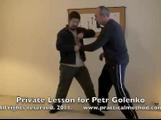Peter Wu led a two-day push-hands workshop in Ottawa, November 11 and 12, 1999. It was the fifth workshop of his North American tour. Other workshops that he held were in Vancouver, Edmonton, Regina, and Winnipeg. In the United States, Atlanta and San Francisco were his other stops.
Peter has more than 30 years of experience in the practice and teaching of taijiquan. This was reflected in the way that he conducted the workshop. Right from the very beginning he laid down the framework very clearly. “Push-hands is one part of the training regime in taijiquan. It is between the form and free fighting.” He was direct, simple, and systematic. Most importantly, he provided information at a pace that was easy to digest. And, he made things easy to understand because he gave analogies; he would frequently demonstrate the points that he was trying to get through.
Peter showed great respect for his teacher, Grandmaster Hong Junsheng, and in the workshop he frequently mentioned his personal experience with the Grandmaster. Peter told us that he had traveled all over China to learn from many taijiquan experts, and that his search for the “true essence of taiji” ended with his meeting with Grandmaster Hong. While many taiji experts could impress crowds with their push-hands by bouncing a person away, they frequently would do it with the person thrown forward horizontally for a few meters. On the other hand, Grandmaster Hong would bounce people vertically with ease; this was a more difficult feat to accomplish, according to Peter.
Citing Grandmaster Hong, Peter instructed us that “Taiji is Peng”. He drilled this dogma into participants of the workshop. He then went and quoted Grandmaster Chen Fake (Grandmaster Hong’s teacher), “In taiji the body has to be Song Kai”. Peter believes that “Song Kai” is the key to Peng. Everybody knows about the importance of Song, but miss out on the other equally important Kai. Peng is achieved through being “Song Kai”. Song is relaxation of the muscles (easy, everyone can do that!); Kai is “opening” of the joints and Peter demonstrated the difference being simply Song and being Song Kai with limp wrist vs. with outstretched palm and fingers.
Peter is fond of using analogies. He explained that finding Peng is like looking for a house using an address. Looking for the right street is like looking for Song. Looking for the correct house is like looking for the correct house number. According to Peter, many people find the right street but most have not found the correct house. A few have the correct house number, but the wrong street!
After providing us with the framework and basic principle, Peter went into the exact push-hands techniques in a systematic way. He coached us on the basic single-hand drill, with same foot forward and then with opposite foot forward. First with horizontal circles and then with vertical circles. In all cases, he was very clear about where each part of the hands and body should be. Then he went into the double push-hands, clearly explaining the four methods of Peng, Lu, Ji, and An. He was very detailed. For example, Peter explained that in Lu the palm that is touching the opponent’s elbow should be outside the elbow, and not on top nor below. He even demonstrated the consequences of not being in the right position. Finally, we ended up with some drills in moving-step push-hands.
In summary, Peter’s workshop was excellent. He was very easy to understand. The workshop went along at a good pace without being rushed. We were asked to keep a few basic principles in mind, and drills were systematically presented. Details that were very useful were provided. Most importantly, Peter showed us a key framework by which to learn and practice taijiquan.
Attending Peter’s workshop was a rich and insightful experience for me and, as one participant commented, “It complemented what Joseph Chen Shifu has been teaching us.” For us in Ottawa and nearby, it is a blessing to have people with such expertise come and coach us.


